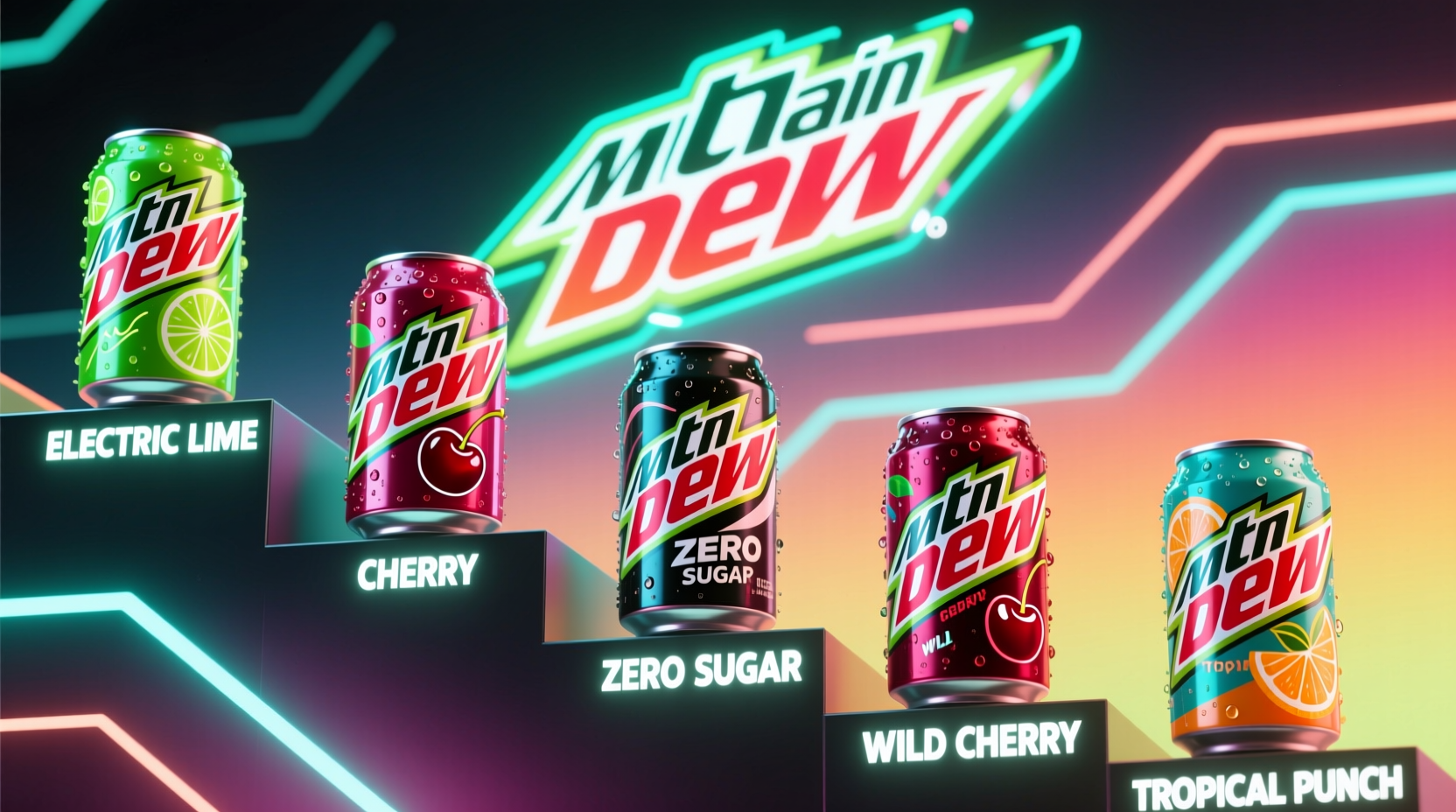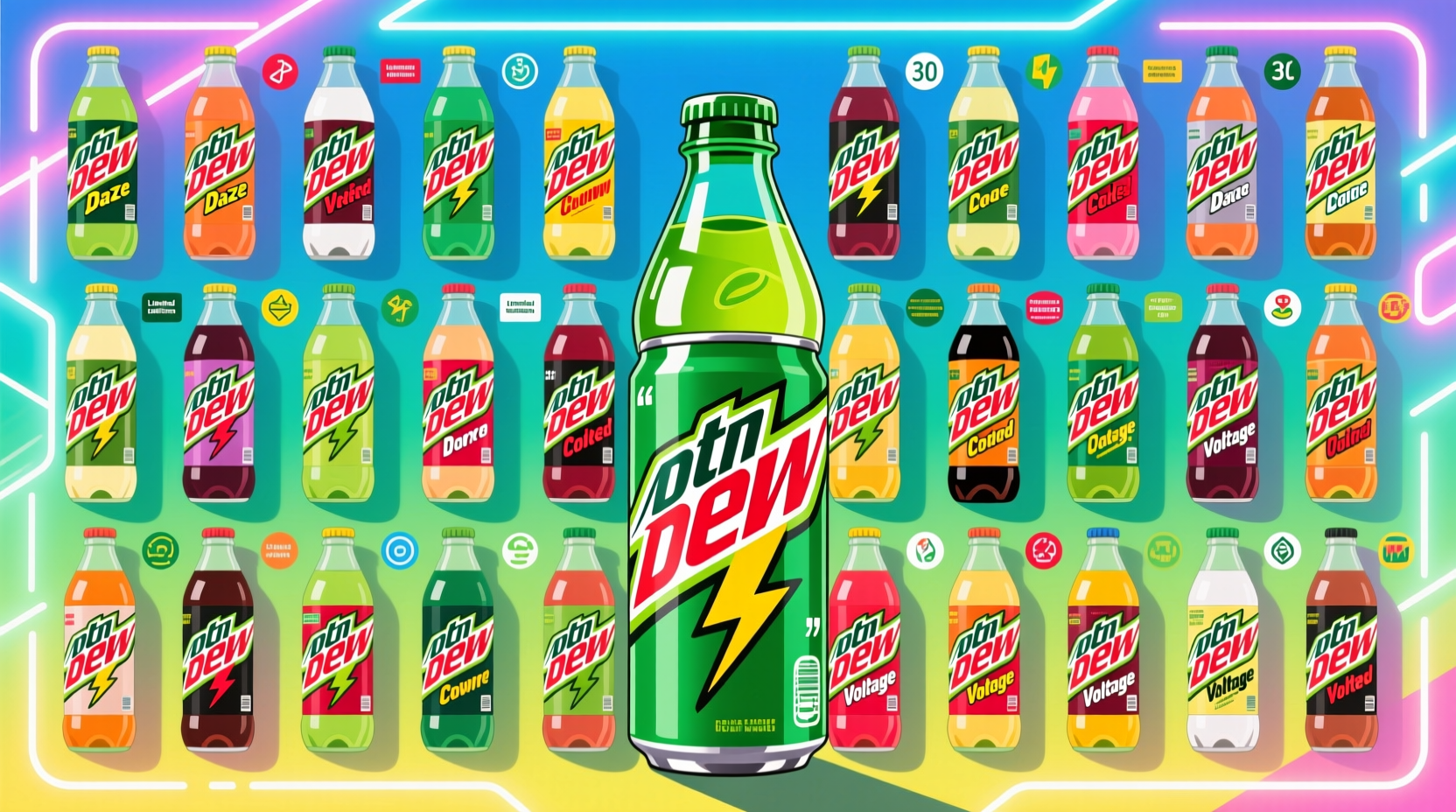Understanding Mountain Dew's Complete Flavor Portfolio
When searching how many flavors of Mountain Dew is there, the answer depends on whether you're counting only current permanent offerings, seasonal releases, or historical variants. As of late 2023, PepsiCo maintains 10 core flavors in regular production across North America, with additional regional specialties available in international markets.

Current Permanent Flavor Lineup
The standard Mountain Dew product range available year-round in most US retailers includes these 10 official flavors:
| Flavor Name | Key Characteristics | Available Formats |
|---|---|---|
| Original Mountain Dew | Citrus-blend with high caffeine content | Cans, bottles, 2L |
| Diet Mountain Dew | Sugar-free citrus version | Cans, bottles |
| Mountain Dew Zero Sugar | Artificially sweetened, zero calorie | Cans, bottles |
| Mountain Dew Code Red | Cherry-flavored citrus | Cans, bottles |
| Mountain Dew LiveWire | Electric blue raspberry | Cans |
| Mountain Dew Pitch Black | Berry-flavored dark variant | Cans, bottles |
| Mountain Dew Game Fuel | Specialty flavors (varies by edition) | Cans |
| Mountain Dew Baja Blast | Tropical lime (Taco Bell exclusive) | Cans, bottles |
| Mountain Dew White Out | Strawberry citrus | Cans |
| Mountain Dew Voltage | Blueberry citrus | Cans |
Flavor Evolution Timeline: How Mountain Dew Expanded Its Range
Understanding how many flavors of Mountain Dew is there requires examining its historical development. According to Beverage Marketing Corporation's industry reports, Mountain Dew's flavor strategy has evolved through distinct phases:
- 1964-1988: Single original citrus flavor (acquired by PepsiCo in 1964)
- 1988-2001: Introduction of first variant (Mountain Dew Throwback with real sugar)
- 2001-2010: Major expansion era (Code Red 2001, LiveWire 2003, Baja Blast 2004)
- 2010-2018: Health-conscious variants (Diet, Zero Sugar)
- 2018-Present: Limited edition experimentation (Game Fuel series, seasonal releases)
This strategic expansion reflects changing consumer preferences documented in International Food Information Council surveys, with Mountain Dew responding to demand for variety while maintaining its core citrus identity.
Limited Edition & Seasonal Releases
When considering how many flavors of Mountain Dew is there, limited editions significantly increase the count. PepsiCo typically releases 2-4 limited edition flavors annually, with approximately 15-20 active limited editions circulating through the product lifecycle at any given time.
Recent popular limited editions include:
- Mountain Dew Major Melon (watermelon flavor)
- Mountain Dew Electric Citrus
- Mountain Dew Ice
- Mountain Dew Rise Energy (energy drink variant)
According to Beverage Digest analysis, limited editions account for approximately 12% of Mountain Dew's total sales volume, demonstrating their importance to the brand's growth strategy despite their temporary nature.
Regional Variations Around the World
The question how many flavors of Mountain Dew is there becomes more complex when examining international markets. While the US maintains 10 permanent flavors, regional adaptations create additional variants:
- Canada: Mountain Dew Pitch Black (exclusive to Canada until 2022)
- Europe: Mountain Dew Energy (lower sugar formulation)
- Middle East: Mountain Dew Citrus Rush (region-specific citrus blend)
- Japan: Mountain Dew Sakura (cherry blossom limited edition)
These regional variations follow PepsiCo's global localization strategy documented in their annual reports, adapting core products to regional taste preferences while maintaining brand consistency.
Discontinued Flavors: A Look Back
Throughout its history, Mountain Dew has introduced and retired numerous flavors. Beverage Industry Magazine reports that approximately 25 flavors have been discontinued since the brand's inception. Notable discontinued flavors include:
- Mountain Dew Voltage (original 2011 version)
- Mountain Dew White Out (original 2007 version)
- Mountain Dew Revolution
- Mountain Dew LiveWire (original 2003 version)
- Mountain Dew Rise (original formulation)
Flavor discontinuations typically follow a pattern documented in Food Business News: products with less than 2% market share after 18 months of launch are typically retired to make room for new innovations.
How Mountain Dew Determines New Flavors
PepsiCo's flavor development process for Mountain Dew involves extensive consumer research. According to their 2022 sustainability report, new flavors undergo:
- 18-24 months of development and testing
- Consumer taste panels with 5,000+ participants
- Regional market testing in select locations
- Sales performance evaluation before national rollout
This rigorous process explains why some limited editions become permanent fixtures while others disappear after a single season.
Practical Guidance for Flavor Exploration
For consumers wondering how many flavors of Mountain Dew is there and wanting to try them:
- Check PepsiCo's official product page for current offerings
- Look for seasonal releases in spring and summer
- Visit Taco Bell for exclusive Baja Blast variants
- Monitor social media for limited edition announcements
- Consider regional availability when traveling
Remember that flavor availability varies by region and season, so the exact number you can access depends on your location and timing.











 浙公网安备
33010002000092号
浙公网安备
33010002000092号 浙B2-20120091-4
浙B2-20120091-4